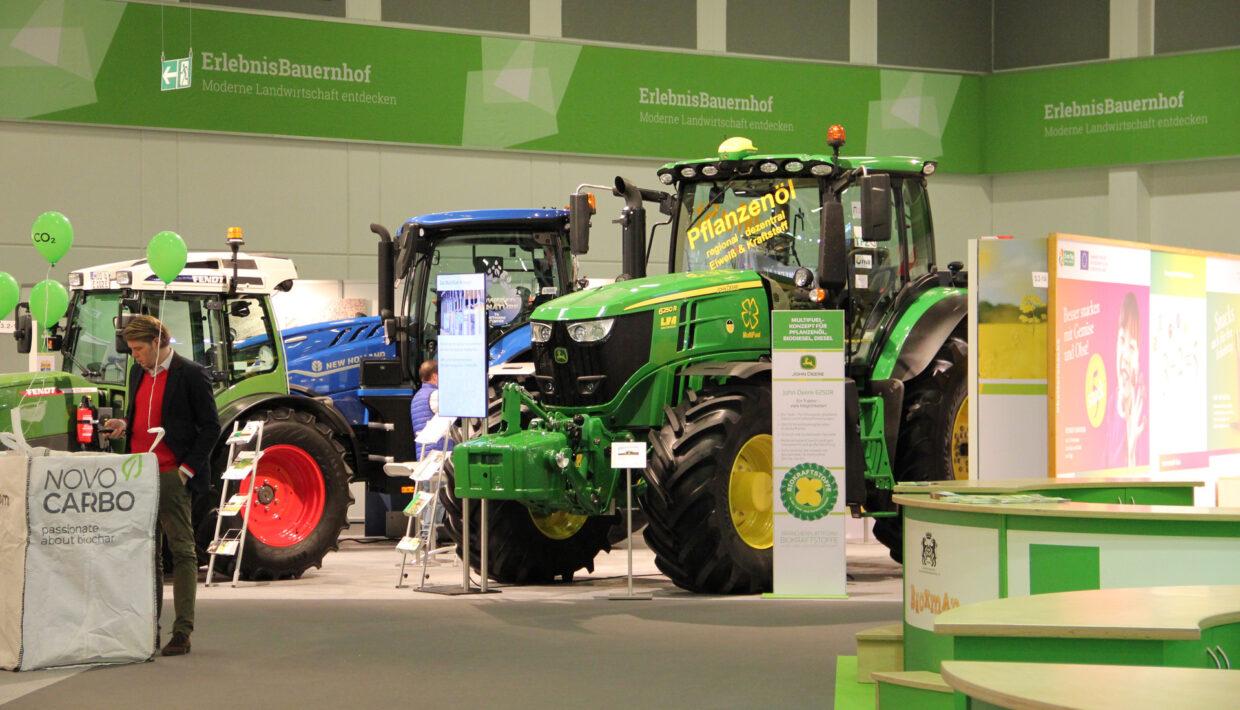Environmental protection and sustainability have been a concern for the general public for several years. While cars and air travel were initially the focus of public debate, attention has now shifted to agriculture and diesel-powered farm machinery. Some ideas that have been suggested include giant batteries, wired machines or climate-neutral fuel. And the list of ideas for more environmentally friendly agriculture is long.

Prof. Peter Pickel, Manager for future technologies, John Deere’s European Technology Innovation Centre, Kaiserslautern
However, many of the ideas cannot yet be implemented on a large scale, or in practice. So creative solutions are needed, especially ones based on existing opportunities and which, when combined, can contribute to climate protection. Even if the consumption of fossil fuels is not the main factor behind greenhouse gas (GHG) emissions in agriculture, the sector must do its part to contribute to climate protection. Agriculture can only be sustainable when it is no longer dependent on fossil fuel consumption.
Ideas for change are generally a good sign. Behind them is a spirit of progress and an imagination for new concepts which will ultimately lead to innovation. Nevertheless, it is important to note that the internal combustion engine is not going to be replaced within the next decade, especially in medium-sized and large agricultural machinery.
While certain approaches and promising prototypes have already been conceived, no equivalent replacement is anywhere close to market maturity. The research is only so far along: The battery for a 250hp tractor which needs to work the fields for eight hours straight would weigh around 1.5t with the current state of technology. In practice, the associated environmental challenges would negate the added value brought by e-mobility.
Behind them is a spirit of progress and an imagination for new concepts which will ultimately lead to innovation.
Another factor is machine longevity. Many tractors and agricultural vehicles last for a very long time. This quality makes a sustainability ‘upgrade’ a difficult decision for users.
Electric tractor with cable
One visionary idea is “GridCON”, an electric tractor from John Deere. It is powered directly from the mains using an extension reel. The cable tractor then travels along previously programmed paths via remote control or autonomously. The cable is automatically rolled out and back in during the journey. To do this, a robot arm puts the cable down next to the first track and picks it up again in the next track. Statistically speaking, the machine can cover up to 16ha, the equivalent of 22 football fields, around a single connection point. But even when a prototype has been made, it will be a long time before such a project is introduced to the market. It is not expected to be ready for series production until 2035 at the earliest.
Current studies show that, thanks to technological advances, machines are becoming more and more efficient. Furthermore, technologies such as precision farming reduce consumption thanks to efficiency gains brought about by digitalisation. Nevertheless, this is not enough to achieve the absolute fuel reduction necessary to contribute to environmental and climate protection in line with the EU’s climate protection goals.
Climate change certainly isn’t taking a break any time soon
That’s because of rising demand for agricultural goods, the intensity of labour required and the associated increases in fuel consumption, which is partly responsible for negating the positive effects described above. At this point it becomes a catch-22 and creates a real challenge. But climate change certainly isn’t taking a break any time soon.
At present, the proportion of agricultural machinery running on alternatives to diesel fuel is practically zero. Agriculture would have to immediately reduce around 20% of GHG emissions resulting from fuel consumption to achieve the climate protection targets for 2030, as would other sectors.

The “GridCON” tractor, as a cable-guided machine unit, also has the advantage that it can run on renewable electricity generated on-site.
Technological advantages like precision farming will be to thank for a good half of this reduction. The only option is to use biodiesel in existing fleets and rapidly promote the development and introduction of alternative drive systems. It is best to adapt engine designs according to the machine size to become more climate-friendly. A flexible interim solution is to combine different fuels.
Political crash barriers required
The use of alternative fuels and drive technologies really depends on their financial appeal. Here, it is up to legislators to create suitable framework conditions. Biofuels produced by agriculture for agriculture could be a particularly interesting avenue. This is because independent production of the fuel required opens up the opportunity to improve value creation on farms.
From a holistic perspective, the production of biodiesel or pure vegetable oil is sustainable, as long as it is produced in limited quantities. Conceivably, we could limit production to a maximum of 8-10% of agricultural land and then concentrate the use of these fuels to agriculture and forestry, so that these sectors can become independent of fossil fuels in the medium term.
In order to assess the agricultural contributions to climate protection, it makes sense to allocate the GHG emission savings from the use of non-fossil fuels to the agricultural sector and not, as is common at EU level, to the transport sector.
The use of sustainable biofuels in agriculture and forestry is currently subject to tax reductions in Germany. However, these tax cuts will only be valid until 31 December 2021. This means there is none of the long-term planning security required for machine manufacturers and users to invest in the corresponding technology. Indefinite tax cuts, similar to those for agricultural diesel, are certainly desirable, as would be a subsidy relating to climate relevance.
eFuels and hydrogen drive
From a global perspective, an increased replacement of diesel with e-fuels – like synthetic fuels produced with the help of renewable energy – is not realistic until 2030 at the earliest. However, for this to become a reality requires the construction of large-scale plants to generate renewable electricity in arid regions of the world. Additionally, these fuels would have to be reserved for economic sectors in which mobility needs cannot (or only to a limited extent) be met by energy electrification. These include aviation and shipping, but also agricultural, construction and forestry machinery.
It will be some time before a revolutionary idea and its practicable implementation conquer the market. But even small steps can have an impact.
Just as with road vehicles, there is great hope that a hydrogen drive in agricultural machinery could solve lots of problems. However, similar to battery technology at the moment, there is still no way to store enough hydrogen in the machines to power a whole working day. And it will be some time before a revolutionary idea and its practicable implementation conquer the market. But even small steps can have an impact.
Multifuel interim solution
A so-called multifuel drive could be operated with several fuels – for example, biodiesel, vegetable oil and diesel. The system would recognise the appropriate fuel and operate accordingly. John Deere is currently working with the German Federal Ministry of Food and Agriculture (BMEL) and the Agency for Renewable Resources (FNR) on a corresponding engine concept.

The restricted use of pure, locally produced vegetable oil like biodiesel as fuel can be a sustainable solution for farmers.
The on-board recognition processes are showing initial success and could be integrated directly into an engine control system. Fuel recognition using artificial intelligence could become a reality in the future thanks to cloud services; they also enable advanced engine diagnostics, like detecting engine load and wear as well as possible pump and injector faults.
However, the solution lies not only in technology. When using vegetable oil, for example, it is important that it is produced locally to avoid having to transport it from the Far East by cargo ship, which is of course harmful to the climate. The ideal solution would be to replace diesel with locally produced plant oil-based fuels with short closed cycles.
Ideas and innovations sprout from the ground, but solutions and implementations do not grow on trees.
A look inside the industry shows that ideas and innovations sprout from the ground, but solutions and implementations do not grow on trees; and it will be several years before climate-neutral or very climate-friendly drives for agricultural machinery are fully developed and brought to market. But simply waiting for this is wrong. What we need to do now is take the first steps towards more sustainable and climate-friendly agriculture with the help of creative interim solutions.
A mixed drive paired with other solutions are the first important approaches. But it is also clear that further innovations must follow. In the field, it is no longer just every grain and every plant that counts, but also every drop of fuel saved.
